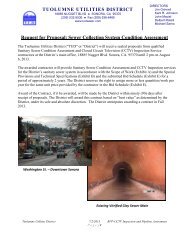Historic Resource Evaluation Project - Tuolumne Utilities District
Historic Resource Evaluation Project - Tuolumne Utilities District
Historic Resource Evaluation Project - Tuolumne Utilities District
You also want an ePaper? Increase the reach of your titles
YUMPU automatically turns print PDFs into web optimized ePapers that Google loves.
Geologically, the area begins east of the Mother Lode belt of the central Sierra Nevada<br />
foothills, and continues through its East Belt and Mother Lode Belt. It lies within the<br />
Columbia, Confidence, Jamestown, Jacksonville, Sonora, and Soulsbyville gold mining<br />
districts, producing both placer and lode gold, but the lode mines have been more<br />
productive (Clark 1970:15). The ditches and their systems were originally constructed to<br />
provide water for mining the rich Tertiary gravels and the limestone belt, primarily<br />
around Columbia, but were soon extended to other placer mining camps and areas, to the<br />
hard rock mines during the Second Gold Rush of the late 1880s-1900s, and eventually<br />
were altered, expanded, and enlarged to serve agricultural and community needs.<br />
The surface of the region as a whole is rugged and broken. In the higher elevations and<br />
timbered areas traversed by the system, the surface soil is more free from rock than in the<br />
lower regions, though slate, shale, and granite are encountered in some localities. The<br />
upper ditches are heavily wooded, largely with sugar pine, ponderosa pine, incense cedar,<br />
and Douglas-fir, requiring extensive clearing of large timber, but little or no brush. The<br />
Columbia System below the Main Columbia ditch crosses the limestone belt that extends<br />
through the county and the cost of ditch construction there was high, as much of the<br />
excavation had to be blasted out of solid rock. Below Columbia the system traverses the<br />
district about Table Mountain, a long, low, lava-capped ridge. The Table Mountain and<br />
Peppermint Creek ditches were cut for almost their entire length in its formation of<br />
cemented gravel (PG&E 1947:3).<br />
Prehistoric Archaeological Background<br />
Early human use of the Sierra Nevada has not been well-documented. Some early points<br />
(generally thought to be 9,000-11,000 years old) have been found regionally, including two<br />
Clovis points, found in the Twain Harte area, as well as at other locations north and south<br />
(Moratto et al. 2011).<br />
As Marvin and Davis-King (2008) so succinctly summarized prehistoric occupation of<br />
the project vicinity:<br />
♦<br />
♦<br />
The first, and ultimately largest, villages were situated near the rivers and their<br />
main tributaries at low elevations (usually below [4100 feet]). The intensive<br />
occupation of the Sierra after circa 1500-1000 B.C. is seen archaeologically in the<br />
. . . Late Martis, Sierra, Crane Flat, [and] Chowchilla . . . phases. [It might also be<br />
noted that the “intensive” occupation is a result of surveys conducted on recent<br />
landforms, and that subsurface surveys may change this assessment].<br />
The highest population densities were found near the ecotones. . . . Few sites<br />
above the snow line were inhabited year-round, and only warm-season camps and<br />
activity stations were to be found in the high Sierra. [Paleoclimatological studies<br />
indicate that the snow line has been ever-changing, altering also the settlement<br />
pattern of the high Sierra].<br />
♦ Cultural innovation and social change between circa 1000 B.C. and A.D. 500<br />
included expansion of trade, increased use of acorns, and as populations grew, the<br />
establishment of major villages in the Upper Sonoran and Transition zones.<br />
♦<br />
Between A.D. 500 and 1400 many lower foothill villages were occupied only<br />
Foothill <strong>Resource</strong>s, Ltd. 1.5 TUD Ditch Sustainability <strong>Project</strong><br />
Francis Heritage, LLC<br />
<strong>Historic</strong> <strong>Resource</strong> <strong>Evaluation</strong> Report




